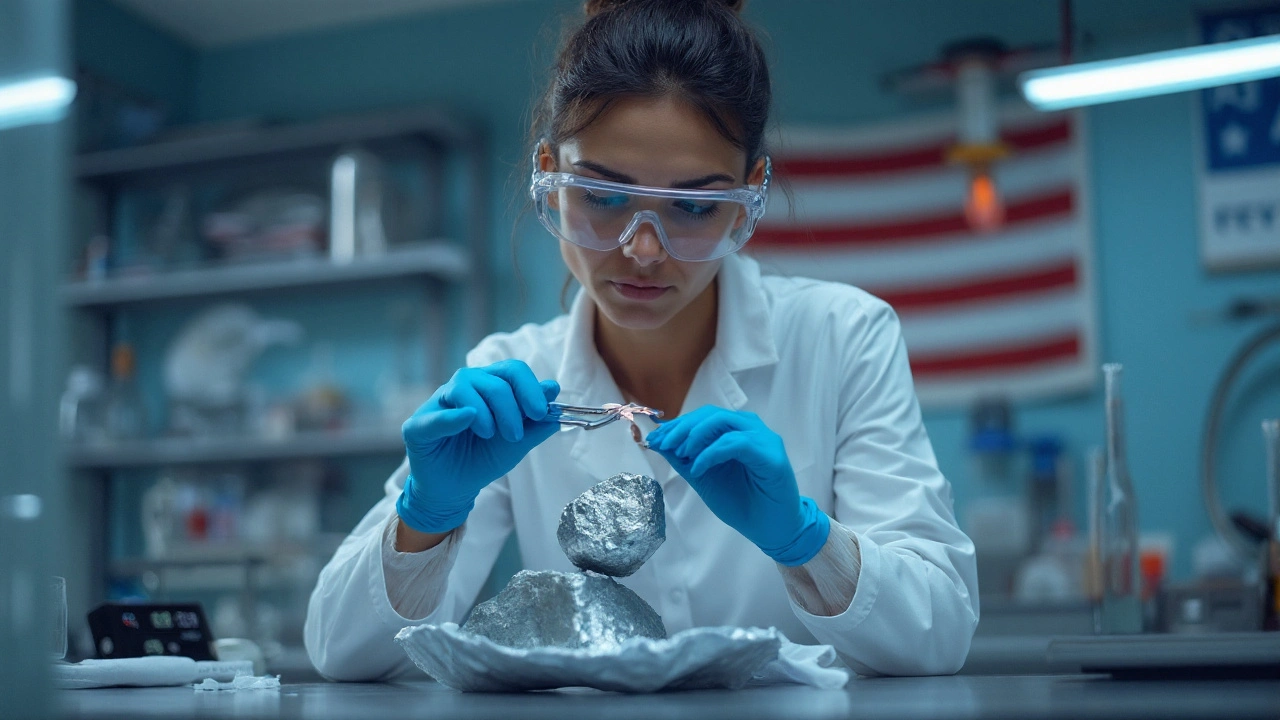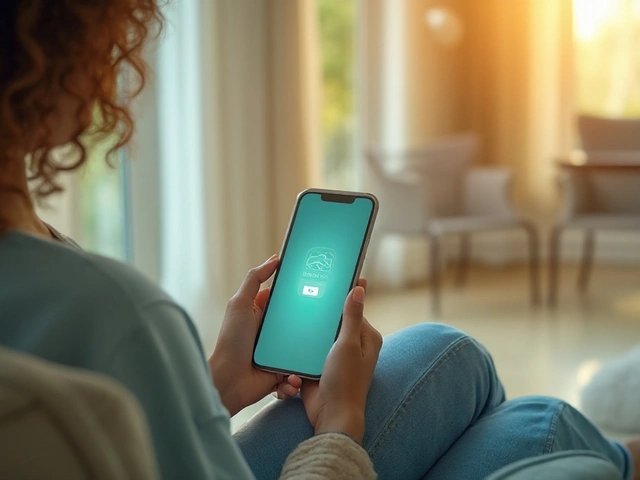TL;DR
- Lithium is the lightest metal, essential for high‑energy batteries and mood‑stabilizing meds.
- Its key properties: low density (0.53g/cm³), high electrochemical potential, and strong reactivity with water.
- Major uses in 2025: electric‑vehicle batteries, grid‑scale storage, psychiatric drugs, aerospace alloys.
- Extraction is shifting toward brine harvesting in South America; sustainability concerns are driving recycling pushes.
- Safety: avoid moisture, store under oil, wear gloves; medical dosing must be monitored to prevent toxicity.
What Lithium Is and Why It Matters
Lithium (chemical symbolLi, atomic number3) sits at the top of the alkali metal group. Its tiny atomic weight makes it the lightest solid element-so light that a cubic centimeter weighs less than a paperclip. This low density translates into high gravimetric energy when lithium atoms move in and out of a crystal lattice, which is why modern rechargeable batteries rely on it.
Beyond energy, lithium ions interact with the brain’s neurotransmitters. Since the 1970s, lithium carbonate has been the cornerstone of bipolar disorder treatment, reducing manic episodes by stabilizing mood swings. The dual role-powering phones and calming minds-makes lithium a uniquely cross‑disciplinary element.
Key Physical and Chemical Properties
Understanding lithium starts with its core characteristics. The table below summarizes the most relevant numbers for engineers, doctors, and everyday readers.
| Property | Value | Why It Matters |
|---|---|---|
| Atomic weight | 6.94g/mol | Lightest metal - critical for weight‑sensitive applications. |
| Density | 0.53g/cm³ | Enables high energy per kilogram in batteries. |
| Melting point | 180.5°C (356.9°F) | Relatively low; requires careful thermal management. |
| Standard electrode potential | -3.04V | Highest reduction potential among metals - drives voltage in cells. |
| Reactivity with water | Violent - produces LiOH + H₂ | Necessitates oil/kerosene storage, impacts handling protocols. |
Because lithium oxidizes instantly in moisture, it’s shipped in airtight, oil‑filled containers. The high negative electrode potential is the engine behind the 3.6-3.7V nominal voltage of Li‑ion cells, a stark jump from the ~1.2V of nickel‑metal hydride packs.
Major Applications in 2025
Three sectors dominate lithium demand today.
- Electric‑Vehicle (EV) Batteries: Over 80% of new‑car lithium consumption goes to Li‑ion packs. A typical 60kWh pack contains roughly 10kg of lithium carbonate equivalent (LCE). As the International Energy Agency reports, global EV sales topped 15million units in 2024, pushing lithium demand past 1million tonnes.
- Grid‑Scale Energy Storage: Utility‑scale batteries smooth renewable output. Projects like the 300MWh Hornsdale Power Reserve in Australia rely on hundreds of megawatt‑hours of lithium chemistry, proving that lithium’s power isn’t limited to cars.
- Pharmaceuticals: Lithium carbonate and lithium citrate remain the only FDA‑approved mood stabilizers. Typical maintenance doses range 600‑1200mg per day, with serum levels tightly kept between 0.6‑1.2mmol/L to avoid toxicity.
Other niche uses include aerospace alloys (lithium‑aluminum for weight reduction), lubricants, and glass‑ceramics. While these niches are smaller, they influence specialty supply chains.

Extraction, Recycling, and Environmental Concerns
Most lithium comes from two sources:
- Hard‑rock mining in Australia’s Greenbushes mine-produces spodumene concentrate that’s later converted to LCE.
- Brine evaporation in the Lithium Triangle (Chile, Argentina, Bolivia). Solar‑driven ponds concentrate lithium salts over 12‑18months.
Both methods have trade‑offs. Hard‑rock mining is energy‑intensive, leading to a 15% higher carbon footprint per tonne of lithium compared with brines, according to a 2023 lifecycle analysis by the International Council on Mining & Metals. Brine extraction, however, raises water‑use concerns in arid regions, sometimes displacing agricultural supplies.
Recycling is closing the loop. In 2024, the EU launched the “Battery Directive 2.0,” mandating 70% collection of end‑of‑life Li‑ion batteries by 2030. Current recycling rates hover around 20% globally, but pilot plants in South Korea and the U.S. are reporting yields of up to 95% lithium recovery using hydrometallurgical processes.
For consumers, the takeaway is simple: buying devices with higher‑capacity batteries extends the useful life of lithium, and returning old phones to certified recyclers dramatically reduces the need for fresh extraction.
Safety, Handling, and Health Tips
Because lithium reacts explosively with water, the following safety rules are non‑negotiable for hobbyists, labs, or anyone storing the metal.
- Store under mineral oil or in an inert‑gas (argon) glove box. Never expose to humid air.
- Wear protective gloves, goggles, and a flame‑resistant lab coat. Even a tiny splash can generate hydrogen gas, a fire hazard.
- Dispose of waste according to local hazardous‑material regulations. Do not pour lithium residues down the drain.
When lithium is taken as a drug, the safety focus flips. Therapeutic dosing must be monitored with regular blood tests because symptoms of toxicity-tremor, nausea, renal impairment-appear once serum levels exceed 1.5mmol/L. Patients should avoid NSAIDs and diuretics that alter lithium clearance.
Key pro‑tips:
- For EV owners, keep the battery management system (BMS) updated; firmware fixes can improve thermal safety.
- When buying a refurbished phone, ask for the battery’s cycle count-lithium capacity drops ~20% after 300‑500 full cycles.
- If you work in a lithium‑brine operation, use wear‑resistant boots and monitor groundwater for elevated salinity.
Mini‑FAQ
- Is lithium the same as lithium‑ion? No. Lithium is the elemental metal; lithium‑ion refers to the rechargeable battery chemistry that shuttles Li⁺ ions between electrodes.
- Can I eat foods high in lithium? Trace amounts exist in vegetables and nuts, but dietary lithium is far below therapeutic doses and has no proven health benefit.
- How long will the lithium supply last? Estimates vary, but most analysts assume current reserves and projected recycling will meet demand through at least 2050, provided extraction practices improve.
- What happens if a lithium battery catches fire? It can undergo a thermal runaway, releasing flammable electrolyte gases. Use a ClassD fire extinguisher or a lithium‑specific fire‑suppressant foam.
- Is lithium safe in pregnancy? Generally, lithium is avoided unless benefits outweigh risks, as it can cross the placenta and affect fetal thyroid function.

Next Steps & Troubleshooting
If you’re a consumer wanting to reduce personal lithium footprint:
- Choose devices with longer warranty and replaceable batteries.
- Participate in local e‑waste recycling programs.
- Consider solar‑powered chargers to offset the electricity used for charging.
If you’re a technician handling lithium metal:
- Double‑check that all storage containers are sealed and labelled.
- If you notice bubbling when lithium contacts moisture, evacuate the area and neutralize with a carbonate solution under a fume hood.
- Keep a ClassD fire extinguisher within arm’s reach.
If you’re a patient on lithium medication:
- Schedule blood‑level checks every 3‑6months.
- Maintain consistent fluid intake; dehydration spikes serum lithium.
- Inform any new prescriber about your lithium regimen to avoid drug interactions.
By aligning your actions with the guidance above, you’ll harness lithium’s benefits while keeping risks in check.








vanessa parapar
September 22, 2025 AT 11:26Lithium in your meds? Bro, that’s just lithium-ion batteries with a therapist. Same chemistry, different vibe. You’re literally charging your mood like a phone.
Sakthi s
September 22, 2025 AT 13:29Good summary. Recycling lithium is the real win here.
Robert Altmannshofer
September 23, 2025 AT 16:22I’ve got a 2018 Tesla and I’ve never once worried about the battery catching fire. The BMS is way smarter than most humans. Still, I drop my old iPhone off at Best Buy now-no more tossing it in the trash. Small wins, right?
Julia Jakob
September 23, 2025 AT 23:39They say lithium is safe but have you seen what they do to the salt flats in Chile? It’s like they’re draining the soul of the earth and calling it ‘sustainable.’ They’re not harvesting lithium-they’re harvesting indigenous water rights. And no one talks about it because the batteries are shiny.
Kathleen Koopman
September 25, 2025 AT 23:16Wait so lithium in my antidepressant is the same stuff in my phone? 🤯 That’s wild. I feel like my emotions are just electrons now. 😅
Abhi Yadav
September 27, 2025 AT 21:42Everything is lithium now. Your phone your mood your dreams. We are all just ions floating in a capitalist sea. The universe is a battery and we are the charge. 🌌
Melania Dellavega
September 29, 2025 AT 01:49I’ve been on lithium for 12 years. The blood tests are annoying but they saved my life. I used to scream at strangers for no reason. Now I just sit quietly and watch the clouds. That’s the real miracle-not the battery, not the mining, but the quiet.
Shannon Wright
September 29, 2025 AT 20:18It’s fascinating how one element bridges the most human and the most technological aspects of our lives. Lithium doesn’t just power our devices-it stabilizes our inner worlds too. That duality deserves more attention. We talk about climate change and mental health as separate crises, but lithium connects them. The same mining that fuels EVs also enables people to live fuller lives. The challenge isn’t choosing between them-it’s doing both ethically. We need policies that protect both the Atacama’s aquifers and the patients relying on lithium carbonate. And yes, recycling needs to be mandatory, not optional. If we can demand 95% recovery rates in labs, why can’t we demand it from manufacturers? It’s not just environmental-it’s moral.
Ben Wood
October 1, 2025 AT 17:15Let’s be real: lithium is not a ‘miracle element.’ It’s a toxic, environmentally destructive, geopolitically messy commodity that we’ve romanticized because it fits our tech utopia fantasy. And don’t get me started on the ‘lithium for mental health’ narrative-it’s not healing, it’s chemical suppression. We’ve outsourced emotional regulation to a mineral mined in a desert by people who can’t afford clean water. And you’re all just here saying ‘cool battery’?!
Nancy M
October 2, 2025 AT 16:03As someone who grew up in a household where lithium was part of daily life, I appreciate this breakdown. My mother took it for decades. I never knew the chemistry behind it until now. It’s strange to think the thing that steadied her mind is the same thing powering the car I drive. There’s poetry in that.
gladys morante
October 3, 2025 AT 14:56They’re lying about the recycling rates. I work in waste management. Most ‘recycled’ batteries go to China and get dumped. The 95% recovery? That’s a lab trick. In the real world, it’s 5%. And no one’s talking about the workers breathing lithium dust in those plants.
Precious Angel
October 5, 2025 AT 02:26You think this is about lithium? No. This is about control. The same corporations that sell you antidepressants also own the mines. They want you dependent-on pills and on gadgets. They profit from your instability. They profit from your charging habits. They profit from your fear. Lithium isn’t the solution-it’s the trap. And they’ve made you love it.
Bethany Hosier
October 5, 2025 AT 07:02While I appreciate the thoroughness of this post, I must respectfully note that the conflation of elemental lithium with lithium-ion compounds is a significant scientific oversimplification that may mislead laypersons. Furthermore, the assertion that dietary lithium has no proven health benefit is inconsistent with emerging epigenetic research, which suggests trace mineral influence on serotonergic pathways. I would urge the author to cite peer-reviewed studies from the Journal of Trace Elements in Medicine and Biology before making such definitive claims.
Krys Freeman
October 6, 2025 AT 16:11Why are we letting China and Chile control lithium? We’ve got the desert in Nevada. We’ve got the tech. We’ve got the brains. Let’s mine it here and stop begging for it overseas.
Rachel Nimmons
October 7, 2025 AT 01:24They say lithium batteries are safe, but I saw a video of one exploding in a delivery van. I don’t trust it anymore.
Jerry Ray
October 7, 2025 AT 05:37Actually, the biggest lithium reserve isn’t in Chile-it’s in the deep sea. They’ve been hiding it under the ocean floor for decades. No one talks about it because the corporations don’t want you to know you can get lithium without destroying land. The real story? It’s all underwater.
David Ross
October 9, 2025 AT 00:35Thanks for the post. I’m a lithium patient and I just wanted to say: don’t stop your meds because of fear. Talk to your doctor. And yes, the blood tests suck-but they’re worth it.